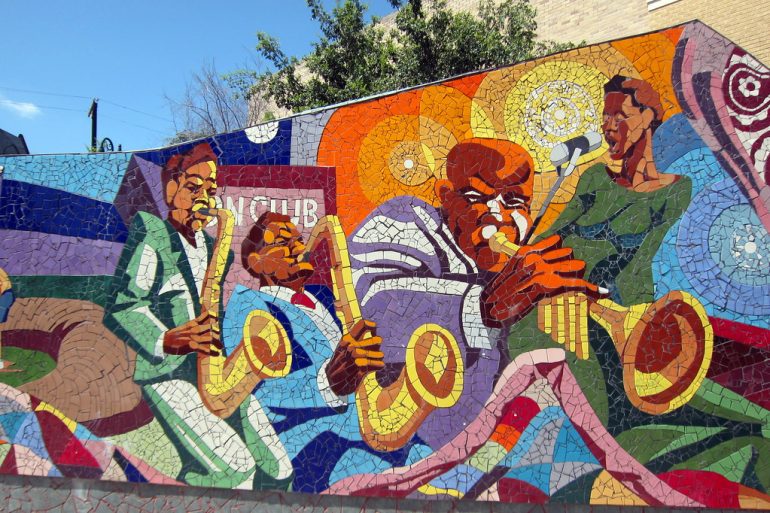While gentrification is hardly unique to Austin, the city’s particular history of racist social engineering has been in the spotlight lately. On March 22, 1928, Austin’s all-white male City Council adopted a plan that required black and brown people from every other part of town to move to East Austin. In a segregated city, it was cheaper for the city to create a single “Negro District” where all their (inferior) facilities could be placed.

soulciti spoke with local activist and Black Leaders Collective Co-Founder, Terry P. Mitchell. She reflected on The 1928 Master Plan. “Black people from 22 freedmen colonies all around the city of Austin were forced to the East Side.” Black people once had settled all over the city. Landowners were low-balled or outright lost their property. Ever since generations of Black Austinites have struggled with “being disenfranchised in many ways, and restitution is in order,” Mitchell stated.
Nook Turner’s Black Austin Coalition has focused on the effects of the Master Plan of 1928 in recent efforts for restitution for Austin’s black community. These efforts recently paid off in a resolution sponsored by Mayor Pro-Tem Natasha Harper-Madison, co-sponsored by Mayor Steve Adler, and several other councilmembers. In addition to the formal apology from the Mayor, Item 67 calls for an analysis of the impact of the Master Plan of 1928 to quantify the resulting economic damage felt by the black community. While City Manager Spencer Cronk’s office will be working with researchers from Huston-Tillotson University and The University of Texas, “we will be doing analysis of our own,” Mitchell said. The resolution also calls for the establishment of a “Black Embassy,” and Mitchell explained that once an estimate of the restitution is determined, the East Austin Embassy will be a “one-stop-shop that provides grants for black homeowners, businesses, organizations, and general economic advancements.”
Despite being born of trauma, East Austin became a thriving home base for generations. There was significant infrastructure that supported the cultural, social, and educational needs of the community. Gentrification has taken hold and centrally located areas, deprived of necessary investment, were left to decay for decades. Now, by design, they have become the most desirable places to “live, work, and play” for people with no ties to the area. As outside developers increasingly purchase more property in East Austin, there are currently few remnants of that infrastructure.
It is said that when America gets a cold, Black America gets the flu. So, what happened when Austin got a winter storm in February that stripped many citizens of heat for a week? The Mt. Carmel Village Apartments community, a complex built in the late 60s, has become a symbol of what economic disenfranchisement looks like. Eureka Holdings currently owns the greatest number of properties in East Austin, including Mt. Carmel. Like most Austinites, the apartment community ended up with no heat or electricity during the recent Winter Storm Euri. However, after determining that the subzero temperatures further damaged the aged gas pipelines and required replacement, gas service was cut off indefinitely. Two-thirds of the residents have been relocated to a hotel or with a family member.
For those that opted to stay, Eureka is providing hot showering stations, free onsite laundry facilities, portable heaters, electric skillets, and electric hotplates. Additionally, they are providing free breakfast and lunch daily.
The decision to relocate residents was met with great skepticism. Turner responded to the relocation decision by saying, “This is a HUD property and they will shut it down and displace those residents immediately to an even [expletive]-er situation! Eureka has to be in compliance with HUD… The city has not held the railroad commission or Texas Gas accountable for keeping the property up to code.”
According to Turner, “These residents have been failed by multiple entities at multiple levels! The first goal has to be placing these residents in better facilities and compensating them for damages.” He continued, “Doing this in any other order will cause lots of collateral damage and may cause an adverse effect!”

While Eureka’s eventual response to the tenants could be described as admirable, Mayor Pro-Tem Harper-Madison expressed disappointment at the neglect and delay initially exhibited by Eureka Holdings. “If I had to grade the response of the property owner, it would be a B-/C+,” she said. “There should have been a more robust tenant/ management connection established in the first place. In addition, my [District One] office was not made aware of the crisis until after the residents had been without gas for ten days! The slow response, along with the lack of skilled help, such as plumbers and leak detection services that everyone in the city was facing, all combined to create the perfect storm of everything going wrong at once.”
Mitchell has been part of the effort to ease the Mt. Carmel residents’ transition to more stable housing. “We’ve set up food trucks and provided water, and more importantly asked questions of the residents themselves,” she shared. soulciti reviewed Eureka’s March 27, 2021 written response to the Mt. Carmel Village Tenant Association’s concerns about the relocation. In response, CEO Rene Campos pledged, among other things, to relocate the residents to safe and sanitary housing with access to the internet, storage, mental health support, and meals that cater to a range of dietary restrictions. According to the memo, “meals have been provided to residents regularly since the challenges began” and efforts will continue to find local sources to support resident needs.
Despite the written response, Mitchell expressed skepticism about the long-term plans for the residents. “What is most concerning to me about this relocation process is that there does not seem to be a transparent, ongoing conversation with the tenants. It is reasonable to be skeptical about what will happen to them after such an extended period of displacement.”

In addition to services related to the relocation, Eureka addressed longstanding areas of neglect, vowing to secure additional maintenance resources to make repairs, respond to pest infestations and restore the use of the community room. There was also a commitment to ensuring that property managers will be provided training on HUD guidance and required to regularly communicate with the community.
Citizens have to be involved in the conversation at all times to maintain diversity in housing.
Harper-Madison spoke to the feeling of vulnerability during times like these. “Some real conversation needs to be had with the black community about the reality of how community expectations meet up with the, to be honest, dark side of capitalism. Citizens have to be involved in the conversation at all times to maintain diversity in housing.” Harper-Madison also made the point that there is a disproportionate application of development pressure on East Austin. “West and Central Austin has built a development shield around their neighborhoods, and all the pressure comes East. We need to talk about that.”
Despite these challenges, the Mayor Pro-Tem expressed optimism about the opportunity the city has to rectify its past and forge a more inclusive and equitable future for its citizens. “I believe there is a will to create equity-driven policy. However, a massive amount of collaboration and investment of time, money, talent and intellect will be required. Not just from those who will directly benefit, but those who agree with it. This means, not just calling my office as the sponsor of Item 67. Call and engage other council members. Call District 5, District 6, District 10 and the others. I’m just one vote. All of us have spheres of influence that should be leveraged.” In an interview on the BG PodCast, Harper-Madison indicated that she was not aware of any other city taking action similar to the passage of Item 67 and expressed hope that Austin “can build the template for other cities to follow.”
Shuronda Robinson, who serves as a facilitator for the newly formed Black Leaders Collective, also spoke with soulciti. She said, “I think there is good will on behalf of the Council, but we have to keep a close watch and be vigilant about ensuring that what’s on paper is actually brought to fruition.”
While the Mt. Carmel Village community is a microcosm of Austin’s tragically racialized past, the city’s official apology, the creation of the Black Embassy, and even Eureka Holdings’ thorough response to its tenants are hopeful nods to the future. Harper-Madison insisted that “At the end of the day, it is critical to get involved and stay involved to stay informed.”












